by I.A. Ahmed and K. el-Shazly
Early weaning reduces the amount of milk consumed by the calves. This not only releases more milk for human consumption, but also helps to keep prices for milk and milk products at reasonable levels, and reduces the cost of rearing the calves during their nursing period. It also facilitates the raising of male calves to a liveweight of about 400 kg, for slaughter at 16 to 18 months.
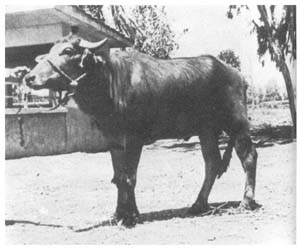
Early-weaned buffalo selected as potential herd sire at the University of Alexandria experimental station
It is common practice in many tropical and subtropical countries to rear buffalo calves by allowing them to suck their dams for varying periods of time from birth to about four months of age. Thus, during the first 15 days after birth, the calves may have access to all the milk the dam produces; during the following 60 days to half the milk; and thereafter, until weaning at around 120 days, to about one quarter of the milk. The quantity of milk so consumed by the calf may range from 230 to 700 kg, depending on the level of milk production of the dam. The economic need to sell liquid milk and milk products has resulted in many buffalo farmers slaughtering or otherwise disposing of their male calves together with a smaller number of female calves at an early age - usually at about 30–40 days, but varying with the size of the calf. Sacrificing several million calves annually at such an early age is without doubt a great loss in view of the serious world meat shortage.
I.A.Ahmed is Professor of Animal Production at the University of Alexandria, Egypt, and K. el-Shazly is Animal Production Officer (Animal Nutrition), FAO, Rome.
Finding solutions
To ameliorate this situation several attempts have been made to lower the cost of rearing buffalo calves during the suckling period. The early efforts of the Alexandria Experiment Station in Egypt, for instance, involved restricting the intake of whole buffalo milk to 340 kg during the first 126 days of the calf's life through pail feeding. During the last few years, however, early weaning with even greater restriction of whole milk consumption has received greater attention because of the possibilities offered by milk substitutes for calf rearing. The substitutes are often based on dried milk and milk products, but the high price of these products in most buffalo-raising countries makes the adoption of milk replacers for feeding buffalo calves impractical. The use of limited amounts of buffalo milk supplemented by adequate quantities of roughages and concentrate dry meal at an early age appeared to offer better prospects of success, and much work has been done along these lines. It is based on the system that is now widely adopted of rearing cow calves on dry feed from about 3 to 5 weeks of age. The basic principle underlying this system involves the induction of adult type rumen function in the calf at an early age by gradually forcing the calf to eat a sufficient quantity of solid feed, roughage of low fibre content, and simple grain mixtures (Preston, 1956).
The objectives of early weaning are:
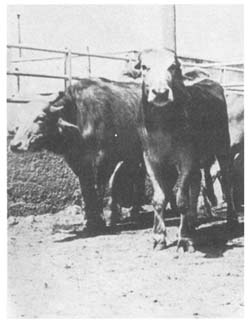 | 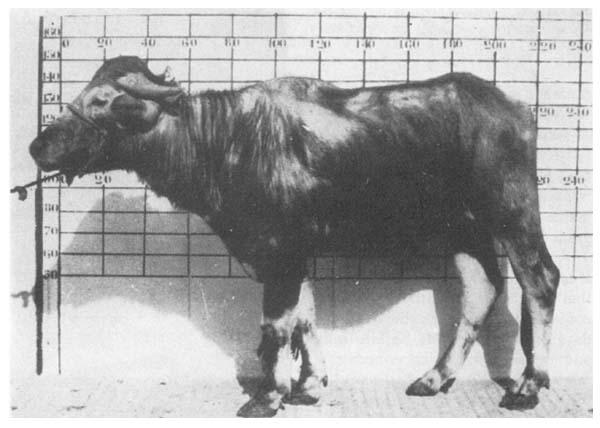 |
| Left: Early weaners 9–12 months old. Above: Early-weaned yearling buffalo bull calf |
Ahmed and el-Shazly (1960) attempted to apply to buffalo calves the same system of early weaning successfully used by Preston (1956) with cow calves, but soon found that it had to be modified for buffalo calves. A series of experiments were therefore carried out using some 300 buffalo calves, male and female, over a number of years. The calves were either born on the farm of the University of Alexandria or purchased from the market at the age of 10–17 days. They were allowed 70–160 kg of milk over a period of 31–61 days, while late-weaned calves received 340–420 kg whole milk in 90–120 days. In the preliminary experiments concentrate feeding was introduced at the age of 18 days, whereas in the later ones the calves had access to this feed from 4–7 days of age. The concentrate mixture used up to the time of weaning (at 45 days) was composed of energy-rich constituents based on grains, and had a TDN value of over 70 percent and a digestible protein content of over 13 percent. After weaning, however, a lower priced concentrate mixture made up principally of cottonseed meal and rice bran, and in some cases of other ingredients, was introduced gradually to replace 10 percent of the pre-weaning concentrate feed at weekly intervals. Some examples of the starter ration and of the lower priced concentrate ration are set out in Table 1. All the rations were supplemented with antibiotics, vitamins and minerals.
A limited amount of a good quality green roughage, berseem (Trifolium alexandrinum), sweet Sudan grass (Sudan grass × Sorghum saccharatum) or berseem hay, was also introduced at about the same time as the starter concentrate mixture (i.e., at 4– 7 days). However, it was noted that unlimited supplies of roughage, although helping to reduce concentrate feed consumption, lowered energy availability and adversely affected growth.
These experiments served to elucidate the following facts:
It may be concluded from the above that early weaning of buffalo calves could be successfully achieved in 45 days on 103 kg whole buffalo milk and on an energy-rich concentrate mixture introduced 4–7 days after birth. A limited amount of good quality roughage should also be introduced at about the same time. Water should always be available. There is no significant difference between early-weaned calves and those weaned at 120 days on 340 kg milk, and although the early-weaned tend to lag behind late-weaned in weight gain, in some cases they reach almost the same weight at 4 months; in others early-weaned calves surpass lateweaned ones. Mortality rates are generally on the higher side for lateweaned calves. An important factor that affects the growth rate of calves, especially those weaned at an early age, is care and management; other nutritional factors tested seem to be of secondary importance.
The cost of rearing calves is perhaps the most important single advantage of early weaning. The cost of 1 kg total digestible nutrients in whole buffalo milk is about 4 to 12 times that in concentrate mixtures. Thus, the cost of 1 kg liveweight gain for calves weaned at 45 days on 103 kg milk is about 28–47 percent lower than that for calves weaned at 120 days on 340 kg milk.
Effect of early weaning on rumen development
It has long been established that volatile fatty acids in the rumen stimulated the early development of papillae in number and size (Sander et al., 1959), while bulk encourages the development of rumen wall muscles (Smith, 1961).
The three photos on this page are of early-weaned buffaloes (from top to bottom) 276, 289 and 319 days of age, and weighing 241, 278 and 353 kg, respectively

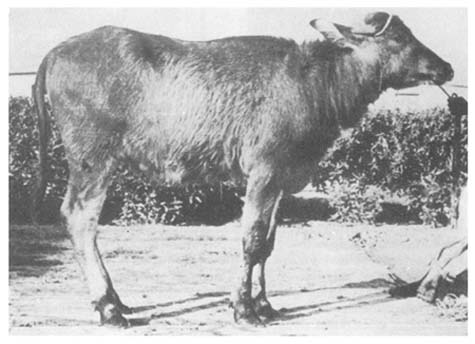
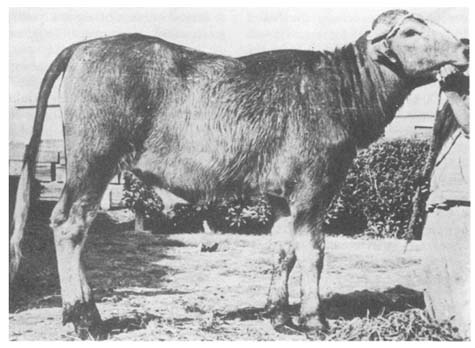
Most of the early-weaned calves in the buffalo experiments outlined above had higher VFA and microbial N concentration in the rumen juice than late-weaned calves. These support the rapid development of rumen function in early weaners. Another indication of this is the decrease of blood glucose levels which was confirmed for early-weaned buffalo calves (Borhami et al., 1967b).
It is clear therefore that buffalo calves do benefit from early weaning systems through improvements in the efficiency of rumen digestion.
Effect of early weaning on the performance of adult animals
General observations on the performance of early-weaned animals showed little variation from that of late-weaned ones. However, it was considered necessary to assess the effect of early weaning on the performance of adult buffaloes in planned experiments.
The results of these experiments (Table 2) showed that there were no significant differences in growth rate at 125 days between early and late weaners, nor were there differences in feed efficiency (kg TDN/kg gain). There was a greater mortality among the late-weaned groups, which may be attributed to the greater incidence of diarrhoea. Cow calves which were weaned at 31 days using the same starter and fed a high concentrate ration from 125 days until slaughter grew at a faster rate and the cost of feeding in their case was 20 percent lower than that of buffalo calves. They reached slaughter age at 480– 540 days, depending on the percentage of native blood in the crosses (native × Friesian).
There was a 26 percent reduction in the cost of feeding of buffalo calves during the whole period, mostly due to reduced milk consumption. Dressing percentages were similar for both early- and late-weaned calves (52.5 and 53.7 respectively). A score card of assessment (Preston et al., 1963) modified to suit the Egyptian consumer's taste, which refuses high fat content in meat, had higher values for buffalo (63.3 and 64.5) than for cross-bred cattle (45.1 and 48.3) (el-Naggar et al., 1970).
Table 1. Composition of some typical concentrate mixtures
| Ingredients | Mixtures | ||||
| 1 | 12 | 3 | 4 | 15 | |
| Percent | |||||
| Maize | 35 | - | 20 | 25 | - |
| Barley | 10 | - | 10 | 5 | - |
| Broken rice | - | - | 20 | - | - |
| Rice bran | - | 65 | - | - | 31 |
| Molasses | 8 | - | 8 | 8 | 5 |
| Pea seeds | - | - | - | 15 | - |
| Beans (Vicia faba) | 30 | - | 20 | 25 | - |
| Linseed meal | 15 | - | 10 | 15 | - |
| Cottonseed meal | - | 32 | 10 | 5 | 61 |
| Calcium carbonate | 1.5 | 2 | 1.5 | 1.5 | 2 |
| Mineral mixture2 | 0.5 | - | 0.5 | 0.5 | - |
| Common salt | - | 1 | - | - | 1 |
| TDN % | 74.00 | 71.90 | 72.80 | 70.80 | 66.10 |
| Digestible protein % | 13.60 | 16.10 | 13.09 | 15.80 | 21.50 |
1 Mixtures 2 and 5 were used to gradually replace mixtures 1 or 3 and 4 respectively from 45 days.
2 307 g ferrous sulfate, 100 g ferric sulfate, 1 g iodine, 10 g copper oxide, 50 g potassium chloride, 10 g manganese sulfate, 3 g zinc oxide, 10 g magnesium sulfate, 1 g sodium borate and 1 g cobalt chloride mixed with 50 kg common salt.
Table 2. Effect of early and late weaning on performance to 400 kg liveweight
| Early weaning | Late weaning | |
| Age at weaning (days) | 45 | 123 |
| Number of calves | 24 | 24 |
| Mortality | 0 | 8 |
| Average daily gain (kg) | ||
| To 125 days | 0.30 | 0.32 |
| From 125 to 363 days | 0.72 | 0.73 |
| From 363 days to slaughter | 0.79 | 0.80 |
| Conversion rate (kg TDN/kg gain) | 5.15 | 4.95 |
| Cost per kg gain (U.S. cents) | 21.0 | 28.0 |
Table 3. Suckling schedule for early-weaned buffalo calves
| Days | System of suckling | Males | Females |
| Kg whole buffalo milk | |||
| 0–11 | Complete udder | 65.5 | 65.4 |
| 12–32 | Two quarters | 69.5 | 67.6 |
| 33–45 | One quarter | 22.4 | 22.6 |
| Total | 157.4 | 155.6 | |
Table 4. Average liveweight (standard deviation in parentheses) daily gain, feed conversion and cost of gain
| Male | Female | |||||
| Age at weaning (days) | 45 | 45 | 90 | 45 | 45 | 90 |
| Number of calves | 9 | 6 | 4 | 7 | 5 | 7 |
| Liveweight (kg) at: | ||||||
Start | 35.9 (4.3) | 34.8 (6.3) | 40.0 (0.5) | 32.4 (4.3) | 35.3 (3.4) | 33.8 (3.1) |
120 days | 110.7 (10.4) | 111.0 (21.5) | 130.7 (9.7) | 102.3 (8.0) | 106.0 (14.3) | 120.0 (9.4) |
12 months | 330.8 (24.6) | 338.3 (33.8) | 360.2 (43.0) | 293.8 (17.2) | 311.6 (33.6) | 316.4 (30.8) |
| Age at 400 kg (days) | 438.0 | 432.0 | 412.0 | |||
| Age at 350 kg (days) | 438.0 | 413.0 | 409.0 | |||
| Daily weight gain (kg): | ||||||
| To 120 days | 0.62 | 0.63 | 0.76 | 0.58 | 0.59 | 0.72 |
121 days to 12 months | 0.92 | 0.95 | 0.96 | 0.80 | 0.85 | 0.82 |
12 months to 400 kg | 0.89 | 0.86 | 0.76 | |||
12 months to 350 kg | 0.72 | 0.72 | 0.69 | |||
TDN intake (kg) | 1 503 | 1 487 | 1 484 | 1 275 | 1 186 | 1 214 |
| Feed conversion1 | 4.13 | 4.07 | 4.12 | 4.02 | 3.79 | 3.84 |
Early weaning and natural suckling — effect on adult performance
Pail feeding - which requires special hygienic measures - is not practised by small farmers who keep buffaloes. It was therefore important to develop a system of early weaning to suit the small farmer and at the same time encourage him to keep the calf after 40 days.
In this system (see Table 3), 150–160 kg milk were suckled by calves in 45 days. Starters containing 13.6 to 13.8 digestible protein were used until 45 days and then gradually replaced by lower priced concentrate mixtures to 120 days. The results (Table 4) showed that the daily gain and feed conversion of the early-weaned calves were poorer than those of lateweaned calves during the first four months (0.63 v. 0.76 kg), due to the fact that the latter were receiving a concentrate supplement from 2 months of age. Differences were significant only for female calves (0.58 v. 0.72 kg) but the differences in weight were not significant from birth to slaughter for males and to the time of first conception for females. slaughter weight of 400 kg was reached in 422 to 438 days for earlyweaned calves and in 412 days for late-weaned ones. No differences were noticed for dressing percentage (54 percent), muscle content of carcass, or composition of the tenth rib. Hindquarters weighed slightly less than forequarters, resulting in a lower score of 58 and 57 for early- and late-weaned buffaloes respectively.
The age at first conception was 15.7 and 15.5 months for the early and late groups. All females gave birth to normal calves.
Conclusions
Early weaning of buffalo calves can be successfully undertaken by pail feeding 103 kg. whole buffalo milk or through suckling 150–160 kg of milk in 45 days. In pail feeding, growth rate during the first four months is limited to 0.33 kg/day. Greater improvements in average daily gain can be obtained when natural suckling is employed. This confirms the overriding importance of care and management in calf-rearing.
Since weaning causes an element of stress to the calf, such stress can be particularly dangerous in the case of early weaning, especially during the two to three weeks immediately after weaning and until the calf can consume enough concentrate feed.
The most important advantage gained from early weaning is, of course, the significant reduction in feed cost, which is more than one third of the total cost during the first four months. The effect of early weaning on the performance of the calf when it becomes adult seems to be favourable as a result of early rumen development, and any ill-effects that early weaning might have had during or immediately after weaning appear to be overcome later.
There is considerable scope for the improvement of early weaning using the pail feeding system in order to reach Ragsdale's standard growth rate of 0.59 kg/day (Preston, 1956).
REFERENCES
Abou Akkada. a.r. & el -Shazly, K. 1964. Appl. Microbiol., 12:384.
Ahmed, I.A. & el -Shazly. K. 1960. Alexandria J. Agr. Res., 8: 217.
Borhami, B.E.A., Abou Akkada, A.R., el-Shazly, K. & Ahmed, I.A. 1967a. J. Dairy Sci., 50: 1142.
Borhami, B.E.A., el -Shazly. K. Abou Akkada, A.R. & Ahmed, I.A. 1967b. J. Dairy Sci., 50: 1654.
el -Shazly, K., Khoury, F.K. & Ahmed, I.A. 1967. J. Dairy Sci., 50: 1667.
Khoury, F.C., Ahmed, I.A. & el -Shazly, K. 1967. J. Dairy Sci., 50: 1661.
Mesbah, M.M., el -Shazly. K. & Abou Akkada, A.R. 1972. Rev. cubana Cient. Agric., 6: 311.
el-Naggar, A.A., el-Shazly. K. & Ahmed, I.A. 1972. Anim. Prod., 14: 171.
Preston, T.R. 1956. Proc. Br. Soc. Anim. Prod., 67–77.
Preston, T.R., Whitelaw, F.G., Aitken, F.N., Macdearmid, A & Charleson, E.S.L. 1963. Anim. Prod., 5: 47–51.
Sander, E.G., Warner, R.G., Harrison, N. & Loosh, J.K. 1959. J. Dairy Sci., 42: 1600.
Smith, H.R. 1961. J. Agric. Sci., 56: 105.